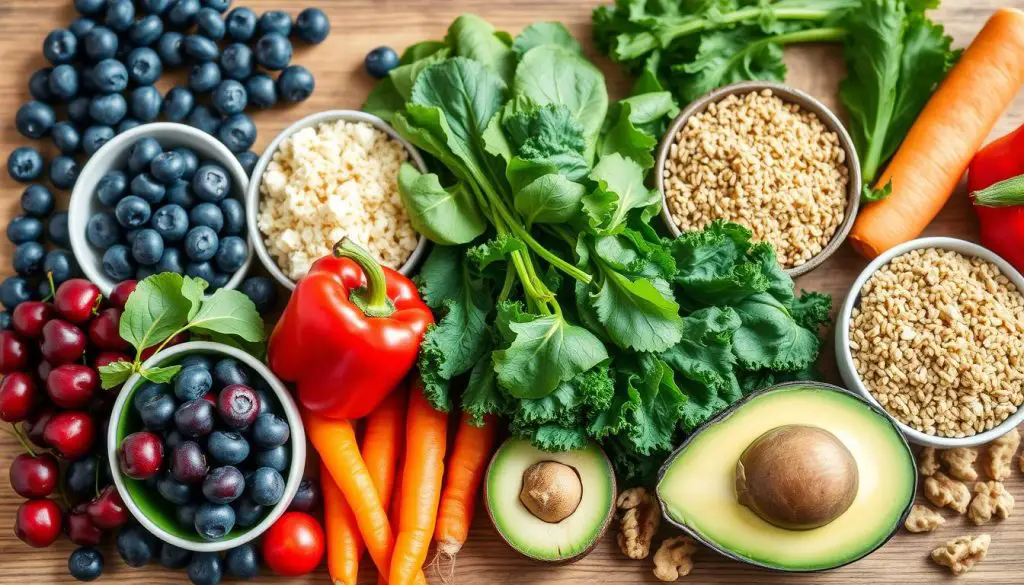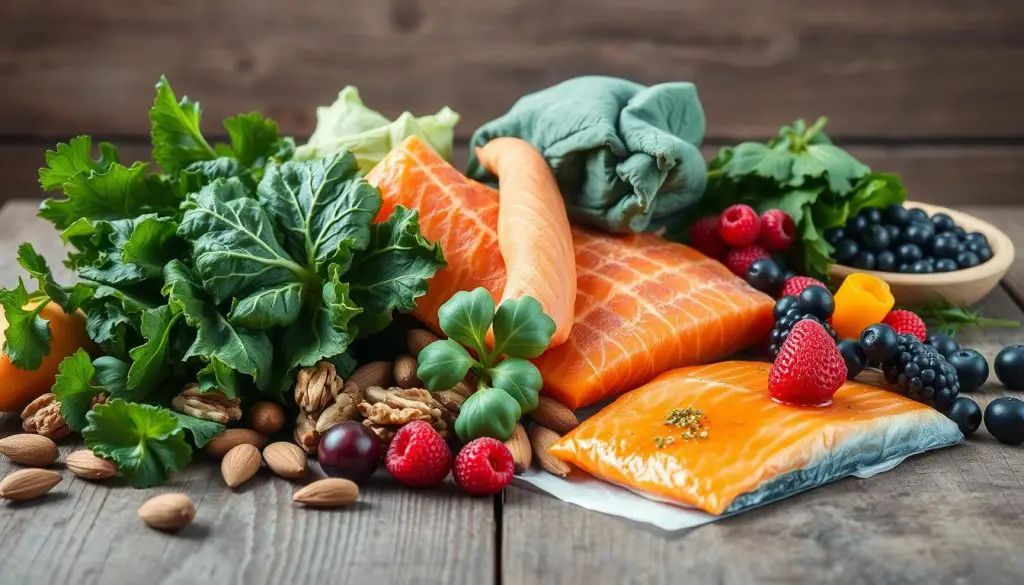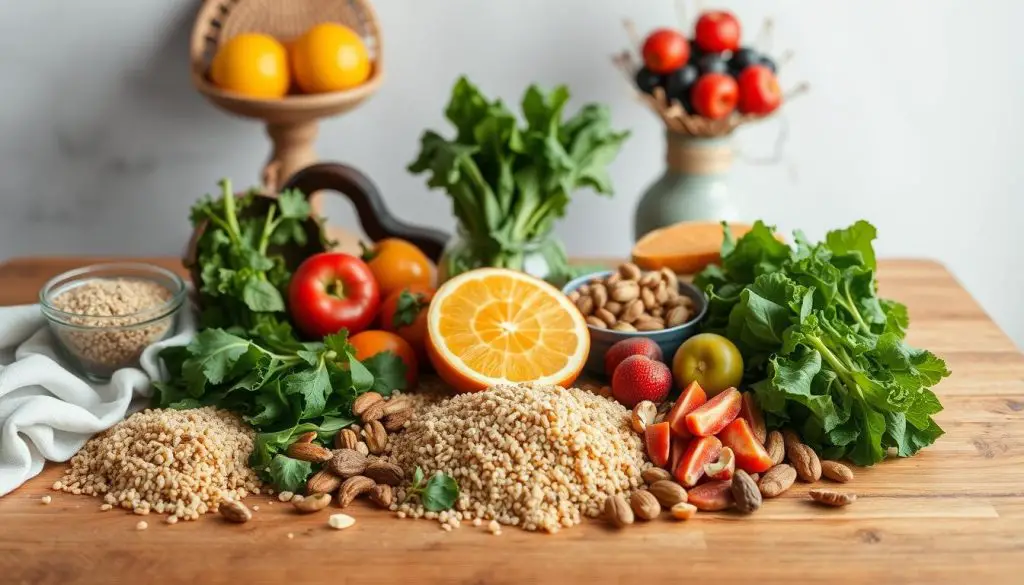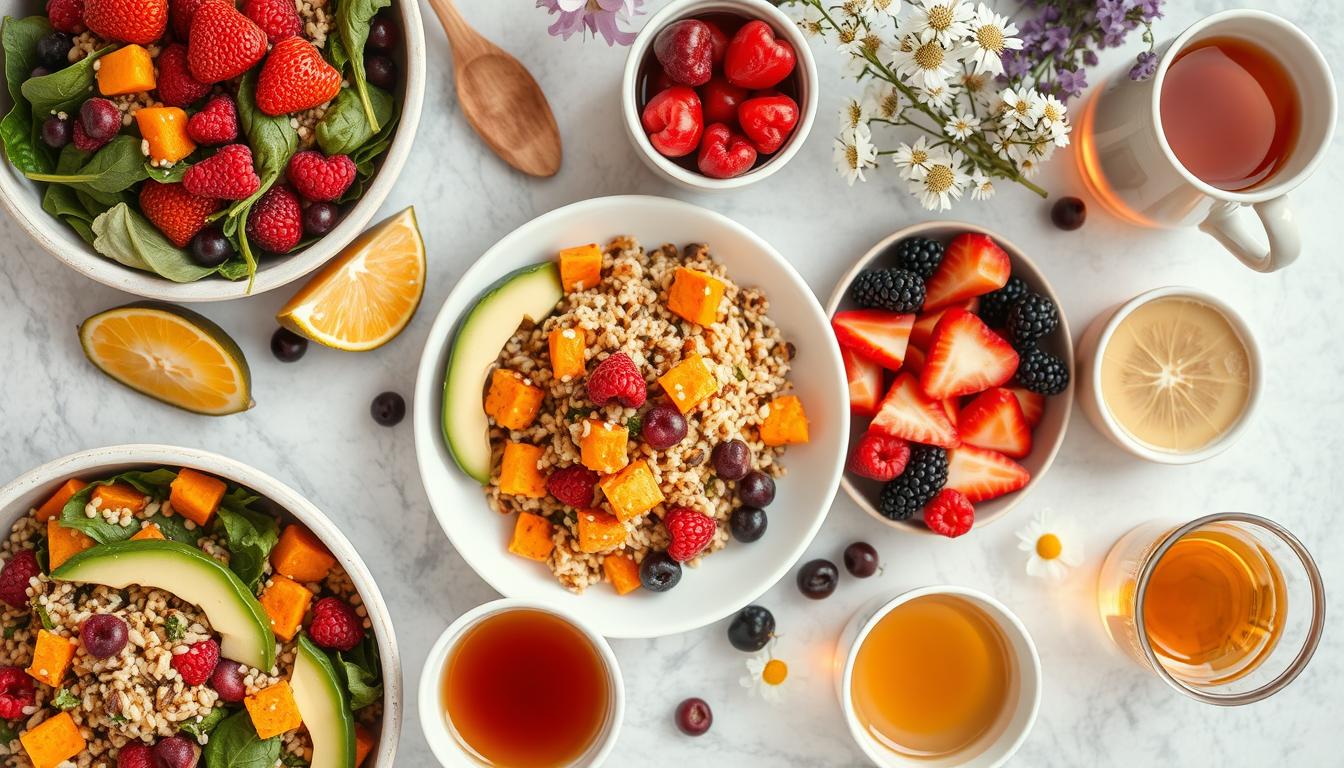Are you one of the 1 in 10 women dealing with endometriosis pain? While there’s no cure, your diet can help manage symptoms. By choosing the right foods, you can ease the discomfort and inflammation of endometriosis.
Endometriosis happens when uterine tissue grows outside the uterus, often on ovaries or fallopian tubes. This tissue thickens, breaks down, and bleeds with each cycle. But it can’t leave the body, causing inflammation, scarring, and painful adhesions.
Following an endometriosis-friendly diet can help manage your symptoms. Eating anti-inflammatory foods and avoiding triggers can help. Let’s look at dietary strategies to ease your endometriosis pain.
Understanding Endometriosis and Its Symptoms
Endometriosis is a chronic condition that affects 7%–15% of women. It happens when cells like the uterine lining grow outside the uterus. This can cause inflammation and painful symptoms.
What is endometriosis?
Endometriosis is a complex disorder. It’s when endometrial cells grow outside the uterus. These cells can attach to organs like the ovaries and fallopian tubes.
Unlike the uterine lining, these cells can’t leave the body. This leads to inflammation, scarring, and adhesions. Adhesions are bands of tissue that can stick organs together.
Common symptoms of endometriosis
The main symptom is pelvic pain. It can be mild or very severe. Other symptoms include:
- Increased pain during periods and intercourse
- Heavy or irregular menstrual bleeding
- Fatigue
- Digestive issues like nausea, bloating, constipation, and diarrhea
- Infertility
If not treated, endometriosis can cause more problems. It can lead to scar tissue and adhesions. These can change a person’s anatomy and make it hard to get pregnant.
If you’re experiencing these symptoms, see a doctor. They can help you find a treatment plan. Early treatment can help manage symptoms and prevent long-term problems.
The Role of Diet in Managing Endometriosis
If you have endometriosis, you know how it can change your life. There’s no cure, but diet can help manage symptoms. Eating right can reduce pain, balance hormones, and improve your life.
Diet affects endometriosis by fighting inflammation. This condition causes inflammation. Eating foods that fight inflammation can help. Omega-3 fatty acids in fish, walnuts, and flaxseeds are good for this.
Your diet also affects hormone balance, which is key in endometriosis. Some foods, like processed meats and dairy, can upset hormone levels. But, eating whole foods can help keep hormones balanced.
Choosing the right foods can help manage endometriosis. Everyone’s body is different, so listen to yours. Work with your healthcare team to find the best diet for you.
Foods to Avoid with Endometriosis
If you have endometriosis, some foods can make your symptoms worse. They can cause inflammation or mess with your hormones. Stay away from these foods to help control your condition:
Trans Fats and Processed Foods
Trans fats are in fried and processed foods. They’ve been linked to more endometriosis cases. These fats can make your body more inflamed, which can make your pain and symptoms worse.
Red Meat and High-Fat Dairy
Eating a lot of red meat might raise your risk of endometriosis. High-fat dairy can also cause inflammation and hormone problems. Cutting down on these foods might help you feel better.
Gluten and High-FODMAP Foods
Gluten and high-FODMAP foods can make digestive issues worse for those with endometriosis. Trying a gluten-free or low-FODMAP diet might help manage your symptoms.
By avoiding these foods, you might reduce inflammation and improve hormone balance. This could help you feel better. Making dietary changes can be a key part of managing endometriosis.
Anti-Inflammatory Foods for Endometriosis Relief
To fight the inflammation linked to endometriosis, eating foods that reduce inflammation is key. These foods are packed with nutrients and can ease symptoms. They might also slow the growth of endometrial tissue.
Omega-3 Fatty Acids
Omega-3 fatty acids are found in fatty fish, nuts, and seeds. They have strong anti-inflammatory effects. Adding these healthy fats to your diet can lessen inflammation and ease pain from endometriosis. Try to eat 3-5 servings of omega-3 foods each week.
Antioxidant-Rich Fruits and Vegetables
Foods high in antioxidants, like berries, dark leafy greens, oranges, and beets, are also important. They help fight inflammation and oxidative stress. Eating 4-5 servings of these foods daily supports your body’s fight against inflammation.
| Anti-Inflammatory Food | Serving Recommendation |
|---|---|
| Fatty fish (salmon, mackerel, sardines) | 3-5 servings per week |
| Nuts and seeds (walnuts, flaxseeds, chia seeds) | 2-4 servings per week |
| Berries (blueberries, raspberries, strawberries) | 1-2 servings per day |
| Leafy greens (spinach, kale, arugula) | 2-3 servings per day |
| Citrus fruits (oranges, grapefruits) | 1-2 servings per day |
| Beets and other root vegetables | 2-3 servings per week |
By adding these anti-inflammatory foods endometriosis to your diet, you support your body’s healing. This can help you find relief from endometriosis symptoms.

The Importance of Fiber for Hormone Balance
Fiber is key in managing endometriosis by balancing hormones, like estrogen. Too much estrogen can make symptoms worse. But fiber helps get rid of extra estrogen through digestion.
Adults need 35 grams of fiber each day. You can get this from fruits, vegetables, whole grains, legumes, nuts, and seeds. Start adding more fiber slowly and drink plenty of water to avoid stomach issues.
Research shows cutting fat in half can lower estrogen by 17%. People who eat a lot of packaged foods, refined grains, meat, or dairy often don’t get enough fiber. Eating a lot of fiber can also make menstrual pain less severe.
The BioCycle Study looked at 250 women aged 18–44 for 2 cycles. It found that eating more fiber is linked to lower hormone levels. But it also found that too much fiber can increase the risk of not ovulating.
In the U.S., women on average get only 13.8 grams of fiber a day. The American Heart Association, USDA, and IOM suggest 20–35 grams of fiber daily. But most women don’t reach this goal.
Eating more fiber can help keep hormones in check. This can ease symptoms of endometriosis like constipation and irregular bowel movements.
Nutrients That May Help with Endometriosis
Some nutrients can help manage endometriosis alongside a fiber-rich diet. These minerals and vitamins are key for hormone balance and pain relief. They help reduce inflammation and ease symptoms of this chronic condition.
Magnesium and Zinc
Magnesium relaxes muscles and eases menstrual cramps. It also helps regulate hormones. You can find magnesium in leafy greens, nuts, seeds, and whole grains. Zinc supports hormone health and menstrual cycles. Seafood, poultry, and legumes are rich in zinc.
Vitamins C and E
Vitamins C and E are strong antioxidants that fight inflammation and pain. You can find them in citrus fruits, bell peppers, broccoli, and leafy greens. Endometriosis symptoms may improve with these nutrients.
Eating foods rich in these nutrients can help manage endometriosis. Always consult your healthcare provider for a personalized plan. They can tailor it to your specific needs and symptoms.

diet for painful periods
If you’re one of the up to 90% of people who experience painful periods, known as dysmenorrhea, changing your diet can help. An endometriosis-friendly diet includes foods that fight inflammation and balance hormones. This can also help with painful periods caused by endometriosis, PCOS, or other issues.
Eating foods high in omega-3s, fiber, magnesium, and antioxidants can reduce inflammation. This can ease menstrual cramps and other symptoms. Avoiding foods that cause inflammation, like processed items and red meat, can also help.
Here are some tips for managing painful periods:
- Prioritize omega-3-rich foods like fatty fish, flaxseeds, and walnuts to help counter inflammation.
- Eat plenty of fiber-rich fruits, vegetables, and whole grains to support hormone balance.
- Include magnesium-rich foods such as leafy greens, nuts, seeds, and whole grains.
- Incorporate antioxidant-rich foods like berries, dark leafy greens, and green tea.
- Limit your intake of pro-inflammatory foods like processed snacks, red meat, and high-FODMAP items.
Choosing the right foods and listening to your body can help manage painful periods. Always talk to a healthcare provider if your symptoms are severe or last a long time.
Considering a Gluten-Free or Dairy-Free Diet
For those with endometriosis, cutting out certain foods might help. Gluten-free and dairy-free diets could offer relief for some women.
A 2012 study found that 75% of women with endometriosis felt less pain after avoiding gluten. Another UK study showed a 50% pain reduction after three months on a gluten-free diet. Women who avoided gluten and dairy and ate more fruits, veggies, and whole foods felt less stressed and healthier. They also had less swelling, better sleep, more energy, and improved mental health.
A low-FODMAP diet might also help manage endometriosis symptoms. If diet changes don’t help enough, trying a gluten-free or dairy-free diet for a month could be worth it.
But, a gluten-free diet might make it hard to get enough fiber, which is good for your bowels. Working with a registered dietitian can help you meet your nutritional needs while managing your endometriosis through diet.
| Diet Approach | Potential Benefits | Considerations |
|---|---|---|
| Gluten-free |
|
|
| Dairy-free |
|
|
| Low-FODMAP |
|
|

Every woman’s experience with endometriosis is different. It’s key to work with your healthcare team to find the right diet for you.
Lifestyle Factors and Alternative Therapies
Changing your diet is just the start. Adding other lifestyle changes and alternative therapies can help manage endometriosis. Exercise can lower estrogen and release happy hormones, easing symptoms. Stress management techniques like meditation, yoga, and deep breathing can also help.
Some people find pain relief from endometriosis through acupuncture and massage. These methods can reduce inflammation and boost overall well-being.
Combining diet changes with lifestyle and alternative therapies is key. Healthy eating, regular exercise, and stress relief can help manage endometriosis. This approach can lead to better symptom control and quality of life.
Exercise and Stress Management
- Regular exercise can help reduce estrogen levels and release feel-good hormones, alleviating endometriosis symptoms.
- Stress management techniques, such as meditation, yoga, and deep breathing, may provide relief for those living with endometriosis.
Yoga, Acupuncture, and Massage
- Yoga can help reduce inflammation and promote overall well-being for those with endometriosis.
- Acupuncture has been found to be effective in reducing pain and discomfort associated with endometriosis.
- Massage therapy can also help alleviate endometriosis-related pain and improve overall quality of life.
By taking a holistic approach, you can manage endometriosis better. This includes diet, lifestyle, and alternative therapies. It can lead to better symptom control and a better life.
Working with a Registered Dietitian
If you’re dealing with the complex symptoms of endometriosis, a registered dietitian can make a big difference. They can look at your specific needs and health to make a diet plan just for you.
A registered dietitian or nutritionist endometriosis specialist can guide you on dietary changes. They can suggest supplements and help with food sensitivities or elimination diets.
Working with a registered dietitian endometriosis expert means a detailed, evidence-based approach. They help ensure you get the nutrients you need for hormonal balance and to reduce inflammation.
So, if you want to manage your endometriosis through diet, find a endometriosis diet plan expert. They can create a diet plan that’s perfect for you.

Supplements for Endometriosis Management
Some supplements can help manage endometriosis. Curcumin from turmeric, vitamin D, N-acetylcysteine (NAC), and flavonoids like quercetin and resveratrol may reduce inflammation and endometrial growth.
Curcumin and Other Anti-Inflammatory Supplements
Curcumin in turmeric can reduce endometriosis cells by lowering estrogen. A study in Italy found that NAC lessened abnormal cell growth and inflammation.
Other supplements like omega-3 fatty acids, vitamin D, and magnesium may also help. Omega-3s can reduce period pain, while vitamin D and magnesium may calm the immune system and reduce inflammation.
| Supplement | Potential Benefits for Endometriosis |
|---|---|
| Curcumin | Reduces endometrial cell growth and excess estrogen production |
| N-Acetylcysteine (NAC) | Decreases abnormal cell growth, inflammation, and inflammatory genes |
| Omega-3 Fatty Acids | Reduces dysmenorrhea and inflammation |
| Vitamin D | Modulates the immune system and reduces inflammation |
| Magnesium | May help manage gynecological conditions involving angiogenesis |
Always talk to your healthcare provider before starting supplements. They can guide you on the right dosage and check for any interactions with your medications.
Endometriosis-Friendly Meal Ideas
Adding an endometriosis-friendly diet to your life can be fun with tasty, healthy meals. For endometriosis breakfast, try a dairy-free tropical smoothie bowl. It’s full of good fats and fiber.
Endometriosis lunch could be a fiber-rich black bean salad. For endometriosis dinner, baked fish with roasted veggies is great. When you need a endometriosis snack, go for elemental granola. It’s made with nuts, seeds, and other good stuff for endometriosis.
Planning an endometriosis meal plan with anti-inflammatory foods can help. It can reduce inflammation, boost your immune system, and balance estrogen levels. This can ease your symptoms. Many women have found relief from painful periods and other issues by trying this.
Keep in mind, everyone’s body and diet needs are different. It’s key to work with a registered dietitian to create a endometriosis-friendly plan that fits you. By adding these endometriosis-friendly meals to your day, you can help manage your condition and feel better overall.
Source Links
- https://www.healthline.com/health/endometriosis/endometriosis-diet
- https://health.clevelandclinic.org/endometriosis-diet
- https://www.hopkinsmedicine.org/health/wellness-and-prevention/period-pain-could-it-be-endometriosis
- https://www.webmd.com/women/endometriosis/understanding-endometriosis-symptoms
- https://www.ncbi.nlm.nih.gov/pmc/articles/PMC8677647/
- https://www.medicalnewstoday.com/articles/in-conversation-how-diet-may-help-with-endometriosis
- https://www.kofinasfertility.com/patient-info/managing-endometriosis-through-diet
- https://www.medicalnewstoday.com/articles/321471
- https://healthmatch.io/endometriosis/what-foods-to-eat-or-avoid-with-endometriosis
- https://www.ssmhealth.com/SSMHealth/media/Documents/slucare/services/obstetrics-gynecology-womens-health/endometriosis-diet-booklet.pdf
- https://www.verywellhealth.com/endometriosis-diet-7105372
- https://www.pcrm.org/good-nutrition/nutrition-information/using-foods-against-menstrual-pain
- https://www.ncbi.nlm.nih.gov/pmc/articles/PMC2744625/
- https://www.bswhealth.com/blog/endometriosis-diet-what-to-eat-if-you-have-endometriosis
- https://www.health.com/condition/endometriosis/endometriosis-diet
- https://www.allianceobgyn.org/blog/diet-endometriosis
- https://healthmatters.nyp.org/what-to-eat-during-your-period-foods-that-help-reduce-cramps-and-foods-to-avoid/
- https://www.thewomens.org.au/health-information/periods/healthy-periods/exercise-diet-periods
- https://thedietologist.com.au/gluten-free-diet-for-endometriosis/
- https://yoppie.com/blog/gluten-free-light-help
- https://www.ncbi.nlm.nih.gov/pmc/articles/PMC10507348/
- https://www.ncbi.nlm.nih.gov/pmc/articles/PMC6117855/
- https://www.mountsinai.org/health-library/condition/menstrual-pain
- https://www.ncbi.nlm.nih.gov/pmc/articles/PMC6723319/
- https://www.todaysdietitian.com/newarchives/0316p50.shtml
- https://www.ubykotex.com/en-us/resources/period-everyday-life/period-foods-and-nutrition
- https://www.ncbi.nlm.nih.gov/pmc/articles/PMC8972862/
- https://www.medicalnewstoday.com/articles/321402
- https://www.wholefamilyhealth.ca/top-5-supplements-for-endometriosis-symptom-relief/
- https://www.businessinsider.com/guides/health/conditions-symptoms/endometriosis-diet
- https://www.everydayhealth.com/womens-health/essentials-of-endometriosis-diet.aspx
